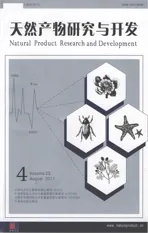藏药船型乌头中的生物碱成分
2011-03-17黄圣卓曹金鑫蒋思萍朱华结
黄圣卓,曹金鑫,蒋思萍,朱华结
1中国科学院昆明植物研究所植物化学与西部植物资源持续利用国家重点实验室,昆明650204; 2西藏高原生物研究所,拉萨850001;3中国科学院研究生院,北京100049
Introduction
The plant genus Aconitum(Ranunculaceae)has over 100 species distributed in the northern hemisphere.The whole plants of Aconitum naviculare Stapf are used in traditional Tibetan medicine system for the treatment of some inflammations like gastritis,hepatitis,nephritis[1].Crude preparations from Aconitum species were popularly used in Asia,Alaska,and Europe[2]in folklore and traditional medicine for the treatment of traumatic injury[3],as febrifuge and bitter tonic[4],and as ingredients in intoxicating liquor[5].However,little phytochemistry study has been reported on A.naviculare.In this paper,eight alkaloids were isolated from A.naviculare.
Experimental Section
General
Optical rotations determinations were carried on an OA AA-50 digital polarimeter.1H and13C NMR Spectra were recorded on Bruker AM-400 and DRX-500 spectrometers with CDCl3or CD3OD as solvent and TMS as standard.The MS data were recorded by a VG Autospec-3000 mass spectrometer;in m/z(rel.%).Column chromatography were carried out with SiO2(200-300 mesh,Qingdao Marine Chemistry Inc.CHCl3/ MeOH)and Sephadex LH-20(25-100 μm,Phamacia Fine Chemical Co.Ltd.CHCl3/MeOH 1∶1)
Plant Material
Whole plants of A.naviculare were collected from Tibet (China)in June and August 2006.The specimen identified by professor Jiang Si-ping and stored in Plateau Institute of Biology Lhasa.
Extraction and Isolation The dried material(20 kg)was extracted with methanol,a crude methanol extract(2.1 kg)was obtained.It’s solution was acidified with 0.1 M H2SO4.The acidic aqueous extract was then basified(pH 10)with 20%aqueous Na2CO3solution and then extracted with CHCl3.The combined chloroform solution was washed with H2O and dried with Na2SO4,and the solvent was evaporated to afford a crude alkaloid extract(40 g),which was subjected to repeated column chromatography(CC)(SiO2;CHCl3/MeOH,100∶0 to 0∶100).The fractions eluted by CHCl3/MeOH 80∶20(3.6 g) was further purified by repeated CC(1.SiO2,CHCl3/ MeOH,100∶1;2.Sephadex LH-20,CHCl3/MeOH 1∶1)to afford compounds 1(1.5 mg),2(26.7 mg),3(1.6 mg),4(13.7 mg),5(40.5 mg),6(12.0 mg),7 (2.1 mg),and 8(13.0 mg).
Result and Discussion
13-O-Acetylhetisine(1)C22H27NO4,white powder,[α]+20.0(c 0.0015,MeOH),EI-MS(70 eV)m/ z 369[M]+(45),352(12),340(30),326(38),310(100),282(48),253(22),160(21),144 (13),1H NMR(CD3OD,400 MHz)δ:5.02(2H,d,J =2.2 Hz),4.78(1H,s),4.29(1H,d,J=9.0 Hz),3.62(1H,d,J=1.6 Hz),3.58(1H,d,J=1.7 Hz),3.43(1H,s),2.72(2H,m),2.57(1H,d,J=4.9 Hz),2.53(1H,s),2.46(1H,d,J=2.6 Hz),2.30~2.06(9H,overlap),1.84-1.76(3H,overlap),1.21~1.17(4H,overlap);13C NMR(CD3OD,100 MHz)δ:215.4(s),172.4(s),146.7(s),109.3 (t),74.9(d),74.8(d),71.6(d),66.7(d),63.7 (t),61.3(d),55.6(d),50.82(s),50.80(d),48.6(d),45.6(s),40.5(t),36.7(s),36.2(t),34.0(t),33.7(t),29.8(q),21.3(q).Comparing the data to the reported results in literature[6],the structure is defined as 13-O-acetylhetisine.
2-Acetyl-13-dehydro-11-epihetisine(2) C22H27NO4,white powder,[α]+48.7 (c 0.01335,MeOH),ESI-MS(pos.)m/z 370[M+H]+,1H NMR (CDCl3,400 MHz)δ:5.03(1H,d,J=9.0 Hz),4.83 (1H,s),4.68(1H,s),4.05(1H,d,J=9.2 Hz),3.77(2H,s),3.39(1H,d,J=13.9 Hz),3.34 (1H,s),2.99(1H,d,J=12.6 Hz),2.50~2.03 (14H,overlap),1.74(1H,d,J=12.6 Hz),1.16 (3H,s),13C NMR(CDCl3,100 MHz)δ:210.1(s),171.1(s),142.9(s),109.6(t),75.1(d),69.6 (d),69.1(d),65.6(d),61.4(t),57.4(d),54.9 (s),52.1(d),49.8(d),49.1(t),47.2(d),44.2 (s),42.7(t),41.3(s),34.0(t),32.5(t),28.0 (q),21.1(q).Comparing the data to the reported results in literature[7],the structure is defined as 2-acetyl-13-dehydro-11-epihetisine.
2-Acetyl-13-dehydro-11-hetisine(3) C22H27NO4,white powder,[α]+100.0(c 0.0003,MeOH),ESI-MS(pos.)m/z 370[M+H]+(60);1H NMR (CDCl3,500 MHz)δ:5.11(1H,d,J=9.5 Hz),4.94 (1H,s),4.77(1H,s),4.30(1H,d,J=9.0 Hz),3.90(2H,s),3.48(2H,d,J=13.3 Hz),3.10 (1H,J=12.8 Hz),2.65-2.14(14H,overlap),1.89 (1H,d,J=12.4 Hz),1.18(3H,s);13C NMR (CDCl3,125 MHz)δ:211.6(s),170.0(s),143.4 (s),109.7(t),74.1(d),73.1(d),70.3(d),65.3(d),63.5(t),59.7(d),55.4(s),54.2(d),49.8(t),48.9(d),47.8(d),44.9(t),44.4(s),42.3(s),35.1(t),33.1(t),28.5(q),21.0(q).Comparing the data to the reported results in literature[7],the structure is defined as 2-acetyl-13-dehydro–11-hetisine.
Hetisinone(4)C20H25NO3,white powder.[α]+ 16.0(c 0.00685,MeOH),ESI-MS(pos.)m/z 328[M+1]+(83),1H NMR(CD3OD,400 MHz)δ: 4.71(1H,s,br),6.63(1H,s,br),4.28(1H,m),4.20(s,br),4.16(1H,m),3.69(1H,m),3.62 (1H,m),3.20(1H,m),2.78(1H,d,J=6.7 Hz),2.74(1H,d,J=4.0 Hz),2.62(2H,m),2.30~2.39(5H,overlap),1.79~2.11(4H,overlap),1.32 (3H,s);13C NMR(CD3OD,100 MHz)δ:211.3 (s),144.7(s),109.2(t),74.6(d),70.8(d),70.7(d),67.2(d),61.4(t),57.2(d),54.7(d),50.8(d),50.6(d),49.8(d),49.3(t),44.6(t),44.4(s),41.7(s),34.3(t),32.9(t),28.3(q) .Comparing the data to the reported results in literature[8-10],the structure is defined as helisinone.
Neoline(5) C24H39NO6,yellow powder.[α]+ 5.68(c 0.01935,MeOH),ESI-MS(pos.)m/z 438[M+1]+(65).1H NMR(CD3OD,400 MHz)δ: 4.22(1H,d,J=6.5 Hz),4.21(1H,m),3.82(s,br),3.58(1H,d,J=7.9 Hz),3.39(1H,m),3.36 (3H,s),3.33(3H,s),3.30(3H,s),3.29(2H,s),3.27(1H,m),2.97(1H,d,J=11.1 Hz),2.89 (1H,s),2.85(1H,m),2.75(1H,m),2.57(1H,d,J=11.1 Hz),2.25(1H,d,J=6.5 Hz),2.20 (2H,d,J=7.1 Hz),2.20(1H,m),2.08(1H,s),1.95(1H,m),1.65(1H,m),1.63(1H,m),1.59 (2H,m),1.27(1H,s),1.14(3H,d,J=7.1 Hz);13C NMR(CD3OD,100 MHz)δ:84.3(d),80.8(t),79.5(d),76.3(d),75.2(s),73.2(d),64.2 (d),59.4(q),58.6(t),58.3(q),56.5(q),54.4 (d),50.8(s),49.8(d),48.5(d),45.3(d),45.2 (d),42.5(t),41.8(d),39.2(s),31.4(t),30.0 (t),29.8(t),12.6(q).Comparing the data to the reported results in literature[11],the structure is defined as neonile.
Foresticine(6)C24H39NO6,yellow powder.[α]+ 18.5(c 0.00755,MeOH),ESI-MS(pos.)m/z[M+ 1]+(67),1H NMR(CDCl3,500 MHz)δ:4.19(1H,m),4.15(1H,d,J=6.5 Hz),3.65(1H,s),3.62 (1H,d,J=8.0 Hz),3.34(1H,m),3.32(3H,s),3.31(3H,s),3.30(3H,s),3.24(1H,d,J=8.0 Hz),2.67(2H,m),2.51(1H,m),2.45(1H,m),2.26~2.35(3H,overlap),2.16(2H,m),2.03 (3H,m),1.83~1.87(2H,overlap),1.56(1H,m),1.43-1.55(3H,m),1.11(3H,t,J=7.0 Hz).13C NMR(CDCl3,125 MHz)δ:83.1(d),81.8(d),80.2(t),75.9(d),74.2(s),72.2(d),63.8(d),59.2(q),57.9(q),57.0(t),56.3(q),52.1(d),49.4(d),48.2(d),48.2(t),44.8(d),44.0(d),42.8(t),40.3(d),38.1(s),29.8(t),29.4(t),29.3(t),13.0(q).Comparing the data to the reported results in literature[12],the structure is defined as foresticine.
Isoquinoline(7) C9H7N,light yellow oil.ESI+MS m/z 130[M+1]+(78).1H NMR(CDCl3,500 MHz) δ:9.12(1H,s),8.41(1H,d,J=8.2 Hz),7.86 (1H,m),7.71(1H,m),7.56(1H,m),7.50(2H,m).13C NMR(CDCl3,125 MHz)δ:152.2(d),142.4(d),135.8(d),130.3(d),128.4(d),127.3(d),126.9(d),126.1(d),120.1(d) .Comparing the data to the reported results in literature[13],the structure is defined as isoquinoline.
Dianthramide B(8) N-salicyl-4-hydroxyanthranilic acid methyl ester,C15H13NO5,white powder.EI-MS (70 eV)m/z 287[M]+(16),255((9),MMeOH),167((100),M 34ArCOO),135((50),MArCOO-MeOH),121((44),ArCOOH);FAB-MS:286[M–H]–;1H NMR(CDCl3,400 MHz)δ:12.3 (1H,s,-OH),11.9(1H,s,-OH),8.68(1H,d,J= 9.5 Hz),7.79(1H,d,J=8.5 Hz),7.56(1H,d,J =2.9 Hz),7.44(1H,s),7.12(1H,dd,J=9.0,2.9 Hz),6.99(2H,m),3.98(3H,s);13C NMR (CDCl3,100 MHz)δ:170.9(d),171.2(s),166 (s),163.4(s),144.8(s),136.5(d),135.2(d),129.2(d),121.3(d),120.2(d),118.2(d),113.1(d),109.4(d),109.3(s),53.6(q).Comparing the data to the reported results in literature[14,15],the structure is defined as dianthramide B(N-salicyl-4-hydroxyanthranilic acid methyl ester).
Acknowledgements This work was funded by NSFC (30770235 and 30873141)and Chinese Academy of Sciences(YZ-06-1),973 Program(2009CB522304) and Key State Laboratory of Phytochemistry and Plant Resources in West China of Kunming Institute of Botany(P2008-ZZ17).
Reference
1 Editorial board of Flora of China.Flora of China.Beijing:Science Press,1997,27.186-187.
2 Wink M,Le Q,Philip W.In Alkaloids:Biochemistry Ecology and Medical Applications.New York:Plenum Press,1998.11-44.
3 Yue J,Xu J,Zhao Q,et al.Diterpenoid alkaloids from Aconitum leucostomum.J Nat Prod,1996,59:277.
4 Chopra RN,Chopra IC,et al.Chopra’s Indigenous Drugs of India.Calcutta:U.N.Dhur and Sons Pty,Ltd,1958.54-57.
5 Baillie LC,Batsanov A,et al.Synthesis of the A/E/F sections of conaconitine,napelline and related diterpenoid alkaloids of the aconitine group.J Chem Soc,Perkin Trans 1,1998,20:3471.
6 Benn M,Richardson JF,et al.Hetisine 13-O-acetate,a new diterpenoid alkaloid from Delphinium nuttallianum Pritz.Heterocycles,1986,24:1605-1607.
7 Jiang Q,GlinskiJA,etal.Hetisine derivatives,Part 3.Rearrangement of 11-acetyl-2,13-didehydrohetisine and 13-dehydro-2,11-diacetylhetisine.Heterocycles,1988,27: 925-932.
8 Aplin RT,Benn MH,et al.Structure of hetisinone.Can J Chem,1968,46:2635-2636.
9 Jones PG.Crystal structure of hetisinone hydrate,C20H27NO4.Z.Kristallogr,1993,208:344-346.
10 Pelletier SW,Glinski JA,et al.The diterpenoid alkaloids of Delphinium tatsienense Franch.Heterocycles,1983,20:1347-1354.
11 Pelletier SW,Djarmati Z.Carbon-13 nuclear magnetic resonance:aconitine-type diterpenoid alkaloids from Aconitum and Delphinium species.J Am Chem Soc,1976,98:2626-2636.
12 Pelletier SW,Ying CS,et al.The structures of forestine and foresticine,two new C19-diterpenoid alkaloids from Aconitum forrestii Stapf.J Nat Prod,1984,47:474-477.
13 Johns SR,Willing RI.Carbon-13 N.M.R spectra of quinoline and methylquinolines.The magnitude of the vicinal(peri) 3JCCCH coupling constants.Aust J Chem,1976,29:1617-1622.
14 Niemann GJ,Liem J,et al.The amide-type phytoalexin activity of carnation extracts is partly due to an artifact.Phytochemistry,1991,30:3923-3927.
15 Ponchet M,Martin-Tanguy J,et al.Dianthramides A and B,two N-benzoylanthranilic acid derivatives from elicited tissues of Dianthus caryophyllus.Phytochemistry,1984,23:1901-1903.
